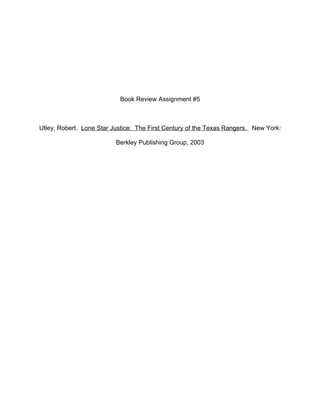
Lone Star Justice Book Review
- 1. Book Review Assignment #5 Utley, Robert. Lone Star Justice: The First Century of the Texas Rangers. New York: Berkley Publishing Group, 2003
- 2. The book Lone Star Justice: The First Century of the Texas Rangers written by Robert M. Utley is more than a history of the Texas Rangers; it is the story about the rise of Texas. What is so compelling about this work is that the author tells the story of the Rangers from their humble beginnings as a part time militia to their rise as the preeminent defenders of the Texas frontier. Mr. Utley dissects the Ranger story in order to separate fact from fiction and talks about the men who founded the unit. He writes convincingly about their virtues and triumphs as well as their defeats and moral setbacks. The history of the Texas Rangers begins with how the Mexicans encouraged Anglo settlers to come in to the region and colonize it, for this provided badly needed tax revenue that the fledgling Mexican government needed. After Texas’ independence from Mexico, more Anglo settlers came into the region; men such as Jack Hays came to the state to seek their fame and fortune. Texas just like most of the nation during the 1830’s still had a very large Indian population for Comanche’s, Cherokees and Kiowa’s roamed the Texas plains and hill country. As more and more settlers moved in, conflict between both groups was inevitable; furthermore, Mexico had not been prepared to give up their northern territory to the Anglos. It was because of all the above mentioned threats that men such as Jack Hayes formed the San Antonio based mounted volunteers. These men were notable because they were independent thinkers and could fight as small independent units; second, these men loved the outdoors and were not afraid to spend time in the elements; third, they knew their foes and they were excellent marksmen with the rifle and pistol.
- 3. Much of Jack Hayes early career focused on his wars with the Comanche’s including his victory at Walker Creek and the introduction of new weapons to combat the Indian menace. Within 10 years of Texas Independence, the United States entered into open conflict with Mexico. It was during this time (1846-1848) that the Rangers capabilities increased as a large fighting force capable of supporting sustained combat operations. Generals Taylor and Scott utilized the Rangers as their cavalry units, cavalry scouts and baggage train rear detachment. At the conclusion of American War with Mexico, the Rangers went back home and continued their duties fighting both the Indians and occasional Mexicans. During the Civil War Years (1861-1865), many of the Ranger units continued to act as the state militia as well as border defense. At the conclusion of the Civil War, the Ranger mission remained the same: Frontier Defense and Indian Fighter. In 1874, Governor Coke institutionalized the Rangers and made the Rangers Texas’ official state militia capable of being called out by the Governor for any state emergency. During the 1870s and early 1880s the Rangers continued to fight the Indians until 1881 when the Indian raids finally subsided. For the Rangers thus began the transition from Indian fighters to lawmen capable of arresting outlaws and enforcing the laws of Texas. During the late 1880’s the size and scope of the Ranger mission focused on law enforcement as the state began to settle and external threats began to subside. In the years leading up to 1910, the Rangers numbers became smaller as their budgets decreased. Lastly, the quality of the individual Ranger varied during these latter times. The Texas Rangers had a lasting impact and took both the credit and blame for some of Texas’ ills during this growth period.
- 4. The thesis of Robert M Utley’s book was that the Rangers were not in the mold of the Lone Ranger television show or folk legend; on the other hand, they were a highly mobile and well armed organized force that helped protect Texas’ frontier from external attack and protect the interior form all sorts of outlaws. The evidence that the author presents is overwhelming because he provides detailed analysis of the Ranger’s leadership, tactics, weapons, organizational structure and political structure as well as their role as a state militia and partner to the U.S. Army Regulars. For the purpose of his research, the author was able to access hundreds of reputable documents through the Texas state archives, Law Enforcement organizations and multiple universities including the Center for American History at the University of Texas. When reading through the authors sources, he may have made a more compelling picture had he been able to procure as many Mexican and Indian sources as possible in order to corroborate historical events. Nonetheless, Mr. Utley’s research accomplished its original objective of telling the true story of the Texas Rangers as well as their overall impact on the state. It is because of Robert Utley’s well thought out research and attention to detail, that his work portrays the realistic challenges of the Rangers in securing their state. In addition, throughout the book the author sheds light on some the Rangers setbacks, including their atrocities during the Mexican and Indian Wars. Furthermore, the author mentions that many of the Rangers had a disdain for Indians, Blacks and Mexicans and occasionally these darker passions would lead to unnecessary violence. Robert Utley’s work not only explains the psyche of the Texas Ranger, but it also ties it in with the core of what made Texas the most unique state in the union.
